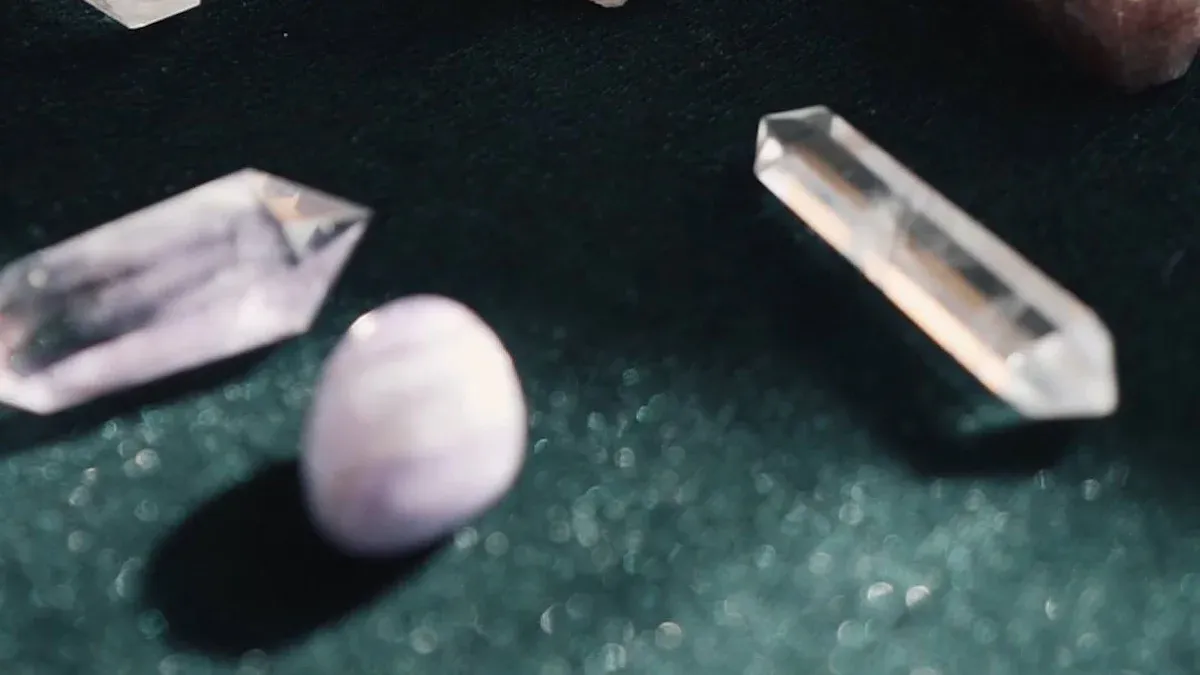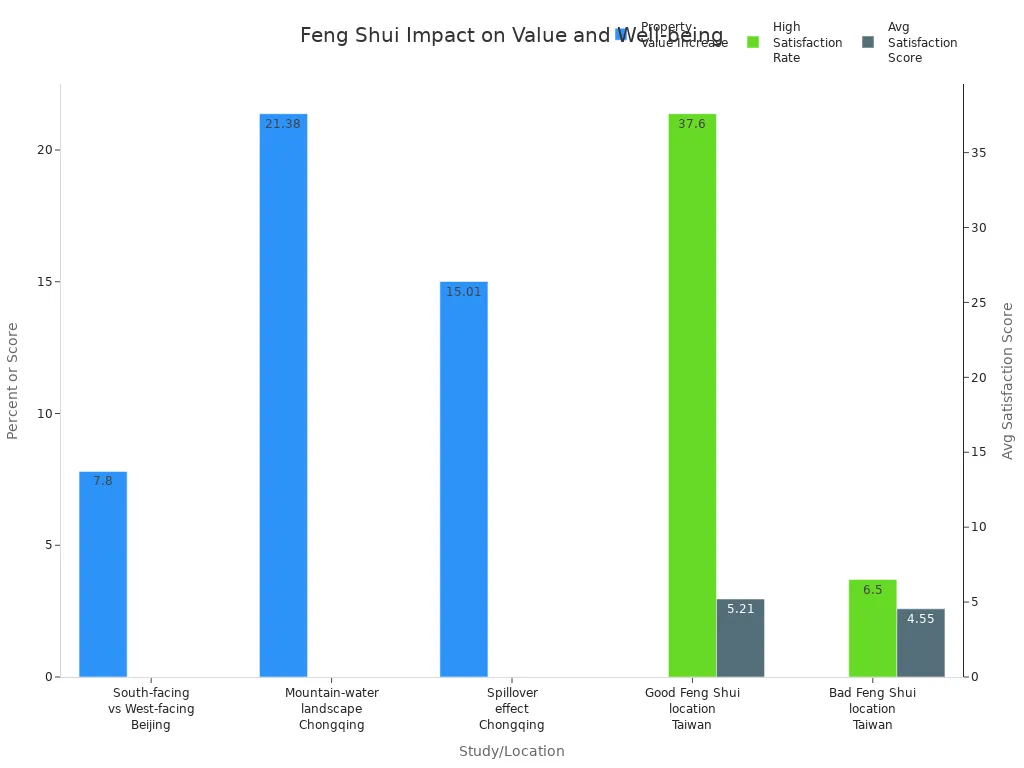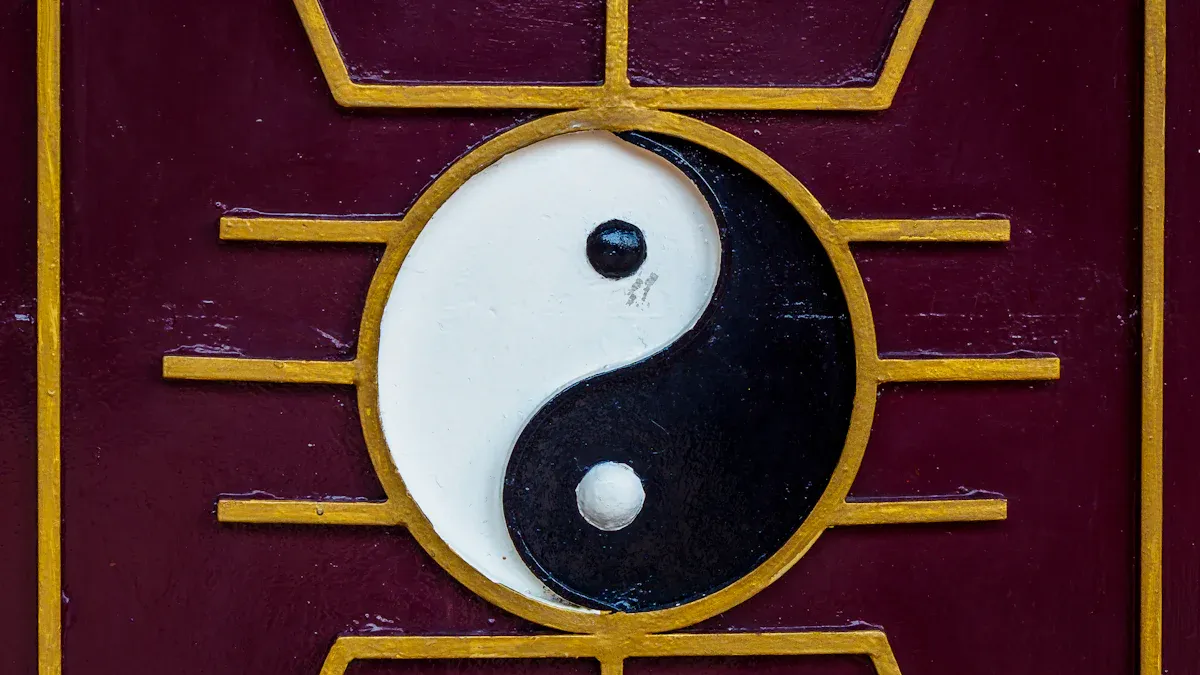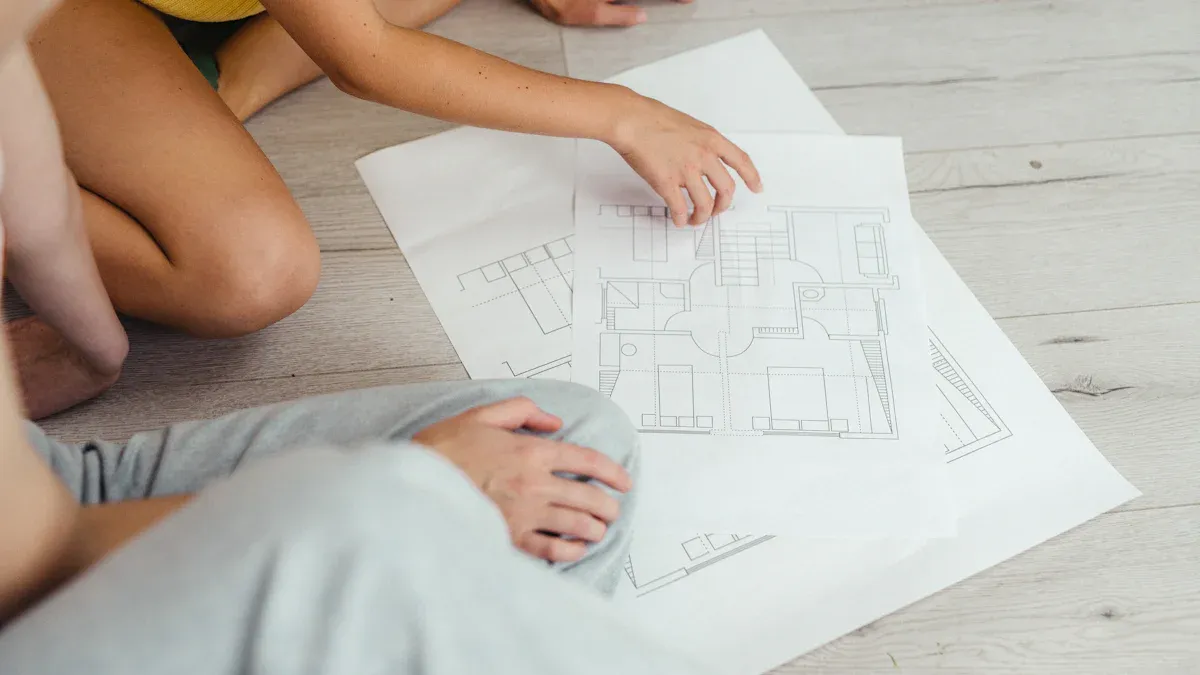
To design your home with a feng shui house plan, you first make a clear plan. Each space should work well with the others. You use feng shui ideas from the start. This helps your home feel peaceful and balanced. Many studies show a good feng shui house plan can help people feel better. It can also make your house worth more money. For example, homes in good feng shui spots make people happier. These homes also sell for higher prices.
Study (Authors, Year) |
Sample Size / Data |
Location |
Type of Evidence |
Key Statistical Findings |
|---|---|---|---|---|
Sia, Yew, and Siew (2018) |
160 respondents |
Malaysia |
Survey |
Feng Shui factors strongly changed what buyers wanted in many places. |
Song, Wilhelmsson, and Zheng (2019) |
63,306 apartment transactions |
Beijing, China |
Transaction data analysis |
South-facing apartments sold for 7.8% more than west-facing ones. |
Liu, Wang, Gu, Liu, and Zhou (2019) |
14,789 apartment transactions |
Chongqing, China |
Transaction data analysis |
Homes with mountain-water views cost 21.38% more; nearby homes went up by 15.01%. |
Survey in Taiwan (N=235) |
235 residents |
Taiwan |
Survey |
37.6% of people in good Feng Shui places were very happy, but only 6.5% in bad Feng Shui places; average happiness scores were 5.21 vs. 4.55. |
Han and Lo (2012) |
18 Feng Shui environments |
Taiwan |
Environmental measurement |
Big differences in land and weather between good and bad Feng Shui sites, which may change how people feel. |

You can use easy steps for picking a site, planning the layout, and placing rooms. Anyone can try feng shui at home, even if you are new to it.
Key Takeaways
Use feng shui ideas like Qi flow, the Bagua map, and the five elements. These help make your home balanced and calm.
Put important furniture in the command position. This lets you see the door but not face it straight on. It helps energy and keeps you safe.
Pick a simple house shape like a rectangle. Use the golden ratio to help energy move easily in your home.
Make sure your main entrance is clean, bright, and friendly. This brings good energy into your house.
Set up rooms so public spaces are close to the entrance. Private rooms should be farther inside. This keeps privacy and helps good energy move.
Basic Principles of Feng Shui

Core Feng Shui Concepts
When you design your home, you start with the basic principles of feng shui. These ideas help you create a space that feels balanced and peaceful. Feng shui principles focus on the flow and balance of Qi, which is the energy that moves through your house. You use feng shui rules to guide how you arrange rooms, furniture, and decorations. The balance of Yin and Yang energies is important. You want to mix calm and active spaces to keep your home feeling good. Two main schools of feng shui exist: the Compass School, which looks at directions, and the Form School, which studies shapes and the environment. You also pay attention to natural light, colors, and materials to support well-being.
Tip: Start with a clear plan and use feng shui principles from the beginning. This helps you avoid mistakes and create harmony.
Feng shui principles center on Qi flow and balance.
The Five Elements (wood, fire, earth, metal, water) shape the energy in each room.
The Bagua map and command position guide furniture and room placement.
Yin and Yang balance keeps your home peaceful.
Feng shui rules help you choose colors, materials, and lighting.
Bagua Map and Five Elements
You use the Bagua map to divide your house into nine sections. Each section matches a life area, such as wealth, health, or career. You learn how to use bagua map by placing it over your floor plan, starting at the main entrance. The five elements connect to these areas and guide your choices for colors, shapes, and materials. (To learn more about the Bagua map and its applications, see relevant article: Bagua Feng Shui Map.) For example, you use green and blue in the Family & Health area to support growth and harmony. If you want detailed feng shui, you match each room to the right element and color.
Bagua Area |
Direction |
Element |
Life Aspect |
Colors |
|---|---|---|---|---|
Fame & Reputation |
South |
Fire |
Fame & Reputation |
Red |
Love & Partnerships |
Southwest |
Earth |
Love & Partnerships |
Pink |
Children & Creativity |
West |
Metal |
Children & Creativity |
White |
Travel |
Northwest |
Metal |
Travel |
Gray |
Career & Path |
North |
Water |
Career & Path in Life |
Black |
Knowledge & Self-Cultivation |
Northeast |
Earth |
Knowledge & Self-Cultivation |
Dark Blue |
Family & Health |
East |
Wood |
Family & Health |
Green, Blue, Teal |
Wealth & Abundance |
Southeast |
Wood |
Wealth & Abundance |
Purple |
You follow feng shui rules to avoid placing bathrooms or kitchens in areas linked to wealth or health. This keeps Qi strong and supports your goals.
Command Position
The command position is a key part of feng shui principles. You place main furniture, like your bed or sofa, so you can see the door but do not face it directly. This helps Qi flow and gives you a sense of safety. You use this rule in bedrooms, living rooms, and offices. When you arrange seating in a semicircle, you support social interaction and comfort. The command position also balances Yin and Yang energies and helps you feel relaxed.
You anchor furniture against a wall with open space in front.
You make sure you can see the entrance from your seat.
You use feng shui rules to create harmony and security.
You improve energy flow and support well-being.
Feng Shui House Plan Essentials
Ideal Home Shape and Ratio
When you make a feng shui house plan, pick a shape that helps Qi stay balanced. Old Feng Shui books say a rectangle or square is best. These shapes let Qi move easily in your home. The rectangle with the golden ratio, 1:1.618, is the top choice. This ratio is found in nature, like DNA and stars. It brings harmony to your house layout. Architects use this ratio for balance and good air flow. Square and rectangle shapes are simple to draw. They help you avoid missing corners or odd shapes that mess up energy.
Tip: Using a rectangle with the golden ratio helps Qi move well and brings good energy to every room.
Most good feng shui house plans use these shapes. L-shaped or triangle homes can make Qi move unevenly, so try not to use them. If your house has a strange shape, you can find the Qi center. Divide the space into rectangles and connect their centers. This keeps air moving and energy balanced.
Site Selection and Orientation
Pick the right land before you start your floor plan. Experts say to choose a big, flat, square, or rectangle plot. This kind of land helps Qi stay balanced and makes planning easier. Stay away from hillsides and weird-shaped plots. They can block Qi and bring bad energy.
Check the soil to make sure it is healthy. Do not pick places with pollution or bad history. Nature around your house matters. Mountains behind and water in front help keep good energy. Line up your house with your birth chart to stop energy problems. Use magnetic north for compass readings to get the best Feng Shui results.
Here are important things for picking a site and setting your house:
Choose a flat, square, or rectangle plot for good Qi.
Stay away from hillsides and odd shapes.
Check soil health and history for good air flow.
Use mountains and water to help good energy.
Match house direction with your birth chart.
Use magnetic north for compass readings.
Make your house fit with nature and nearby buildings.
Avoid loud noises and bad things nearby.
Make driveways curve gently and not point at the front door.
Put water features in lucky spots.
Ask a Feng Shui expert early to fix hidden energy problems.
How your house faces changes how Qi moves and how you feel. The front door is the mouth of your house. It lets good energy come in. Keep the entrance open and bright. Each direction in your house links to a life area, like money or friends. For example, the northwest area helps talking, and the southeast area helps wealth. Use colors and elements in each spot to help Qi move and make your house feel better.
Direction Zone |
Associated Element |
Life Aspect |
Feng Shui Recommendations |
|---|---|---|---|
Northwest |
Metal (Air & Movement) |
Communication, Partnerships |
Use silver, white, or gray; keep fresh flowers or candles; do not keep broken things |
Southeast |
Fire |
Wealth, Prosperity |
Put a stove or fireplace; use red or gold; do not use water here |
Southwest |
Earth |
Stability, Strength |
Put heavy furniture like beds; use earth colors; do not use mirrors |
Center |
Energy Core |
Energy circulation |
Keep open and neat; do not use heavy furniture or walls; use a chandelier or skylight |
Main Entrance |
Gateway for Energy |
Positive energy flow |
Keep bright and welcoming; use plants or symbols; do not block the way |
Public vs. Private Room Placement
Think about where rooms go in your feng shui house plan. Public rooms, like living and dining, should be close to the entrance. These rooms greet guests and help Qi come in. Private rooms, like bedrooms and bathrooms, should be deeper inside. This keeps your privacy safe and lets good energy move around.
When you draw your floor plan, make sure public rooms have good air flow and lots of light. Do not put bathrooms or kitchens in wealth or health areas on the Bagua map. This keeps Qi strong and helps you reach your goals. Make sure rooms are not too big or too small to stop energy blocks. Put bedrooms far from busy places to keep peace and help sleep.
Note: Good room placement helps Qi move well and supports both social and private life.
Main Entrance Design
The main entrance is where good energy comes into your feng shui house plan. Keep this spot clean and free of mess. A nice front door with colors that match your Feng Shui element brings Qi and luck. Use bright lights to make the entrance friendly and help energy move.
Here are ways to bring good energy to your entrance:
Keep the entrance clean and neat for good air flow.
Use a pretty front door with colors that match your Feng Shui element.
Make lighting bright to invite good energy.
Add plants and natural things like bamboo for growth.
Put lucky symbols, like mats with good words or guardian figures.
Keep the path to the door clear and easy to walk.
Use all five Feng Shui elements in your entryway decorations.
You can also use lucky things like horseshoes, elephants with trunks up, and crystals to bring good energy. Pick colors carefully—red for luck, green for peace, gold for wealth. Bring nature inside with houseplants and water features. Use lots of natural light to help Qi come into your home.
Tip: A clean, bright, and friendly entrance sets the mood for your whole house and helps good energy move through every room.
Room Layout and Arrangement

When you plan your home's layout with Feng Shui, you make the space feel balanced and healthy. You can use the Bagua map, five elements, and command position to help energy move in each room. Each part of your home helps a different part of your life, so where you put furniture and rooms is important. Follow these steps to set up each space for the best results.
Living Room and Home Office
Begin with the living room. Put your main sofa in the command position. This means your back is to a solid wall and you can see the entrance, but you are not right in front of the door. This spot helps you feel safe and lets you notice chances as they come. Set other chairs in a U-shape or half-circle to help people talk and keep energy moving. Do not block walkways with big furniture. Keep the room open so Qi can move easily.
Let in sunlight by opening curtains or using mirrors to bounce light. Add plants like bamboo or peace lilies to clean the air and bring good energy. Use colors and things that match the Bagua area you want to help. For example, use green in the Family & Health area or red in the Fame & Reputation spot. Keep the living room neat and free of mess to help energy flow.
For your home office, pick an L-shaped desk for balance and space. Put the desk in the command position, far from the door with a solid wall behind you. Make sure you can see the entrance but are not right in front of it. This setup helps you feel safe and able to focus. Use a chair with a high back for support. Work near a window to get natural light. Use calm colors like blue or green to help you think and feel peaceful. Keep your desk tidy and add things that inspire you. Place a small plant or water feature on your desk to help energy move.
Tip: Put the Bagua map over your living room and office to find key life areas. Boost up to three areas with matching colors, elements, or objects.
Kitchen and Dining Area
The kitchen is the center of your home. Its spot and setup affect health and wealth. Do not put the kitchen where it faces the front door. If you see the kitchen from the entrance, good Qi can rush out, which may cause money or health problems. If you cannot change this, use a screen or tall plant to block the view from the door. Place the kitchen in the East or South part of your home to help the fire element.
Keep the stove away from the sink and fridge to balance fire and water. Make sure the stove is not under a window or facing the main door. Use bright lights and natural things like wood or stone for counters and floors. Keep the kitchen clean and neat to help energy flow. In the dining area, use a round or oval table to help people talk and feel close. Put the table where there is good sunlight and enough space for everyone to move.
Note: If your kitchen must face the front door, use bright lights or music in the living or dining room to change the energy focus.
Bedrooms and Bathrooms
Your bedroom should feel calm and safe. Put the bed in the command position, far from the door with a clear view of the entrance, but not right in front of it. Place the bed's head against a solid wall for support. Leave space around the sides and foot of the bed so Qi can move. Do not put the bed under a window or right in front of the door. If you cannot avoid this, use a mirror to reflect the door or move the bed at an angle.
Pick soft earth colors for bedding and use pairs of items for balance. Hide electronics and clean up often. If your bed faces the bathroom door, always keep the bathroom door closed. This keeps energy from leaving and makes the room peaceful. In the bathroom, keep the toilet lid down and use mirrors to break up bad energy. Keep the bathroom clean and use natural things like stone or wood to make it calm.
Tip: Set up bedroom furniture so air moves well but there are no drafts. This helps you sleep well and keeps energy good.
Furniture Placement and Command Position
Where you put furniture changes how energy moves in your home. Always put important things like beds, sofas, and desks in the command position. This means you can see the door but are not right in front of it. Put furniture against solid walls for support and safety. Do not put beds under windows or right in front of doors, as this can make you feel uneasy and stop energy.
Keep walkways open by not blocking them with big furniture. This lets Qi move and stops stuck energy. Use nightstands on both sides of the bed for balance. Set chairs in a U-shape or half-circle, a little away from walls, to help people talk and keep energy moving. Add natural things like wood and plants to make the room lively. Use mirrors to bounce light and make the space look bigger, but do not put them where they reflect the bed or main door.
Trust how you feel when you move furniture. Change things until the room feels right and balanced. Let sunlight fill the room and use plants to bring in good energy. Keep under beds and sofas clean to help energy move well in your home.
Remember: How you set up your furniture changes how energy moves. A good layout brings comfort, safety, and peace to every room.
Optimising Feng Shui: Practical Tips
Enhancing Chi Flow
You can help Qi move better in your house by letting energy move slowly and softly. Imagine Qi is a friendly animal that wants to visit every room. Keep doors and halls open so nothing blocks the way. Do not put beds or sofas in tight corners. This helps your home feel calm and balanced. Use the Bagua map to find spots that need more good energy. Put plants and flowers in rooms to add life and fresh air. Pick colors that match how you want each room to feel. Mirrors can bounce light and energy, but do not put them right across from beds.
Strategy Area |
Practical Feng Shui Tips |
|---|---|
Decluttering |
Take away mess and broken things to help Qi move and keep peace. |
Furniture Placement |
Put furniture in command spots to help energy move in busy rooms. |
Five Elements |
Add wood, fire, earth, metal, and water things to balance energy in every room. |
Clearing Clutter
A clean space is important for a peaceful home. Mess stops Qi from moving and can make you feel stressed. When you clean up, energy moves better and you feel calm. Many people can focus better and feel less worried after cleaning. For example, one family talked more and felt happier after they got rid of extra stuff. Start by cleaning one room at a time. Use safe cleaners and make a small goal for each time you clean. This careful way brings more good energy into your house.
Using Natural Elements
Natural things help you feel close to nature and bring good energy. Add wood by using plants or wooden chairs. Use fire with candles or red things. Earth comes from clay pots or tan colors. Metal can be picture frames or shiny things. Water, like small fountains or fish tanks, makes rooms calm. Healthy plants like bamboo, snake plants, or peace lilies help Qi move. Put them near windows and take care of them for best results. Things like stone, cotton, and wood also help keep balance.
Lighting and Space Definition
Sunlight is a strong way to bring good energy. Put living spaces near windows to get lots of sun. Use lamps to light up dark spots and show where rooms start and end. Bright lights are good for kitchens and work rooms. Soft lights help bedrooms and living rooms feel peaceful. Good lighting helps energy move and makes you feel good in every room.
Common Mistakes to Avoid
Lining up the front door with a window or back door lets good energy leave.
Not enough lights can stop energy from moving.
Bad air flow keeps bad energy inside.
Mirrors across from beds or the front door are not good.
Not thinking about kitchen Feng Shui, like putting it near the door.
Keeping messy rooms or using fake plants.
Feng Shui Tips for Beginners
Feng Shui Tip |
Explanation and Purpose |
|---|---|
Five Elements |
Use earth, metal, water, wood, and fire in every room to keep energy balanced. |
Commanding Position |
Put beds, desks, and stoves so you can see the door but are not straight in front of it. |
Entryway |
Keep the main door clean, bright, and open for good energy. |
Living Room |
Set up seats to face each other and add healthy plants. |
Kitchen |
Keep it clean, especially the fridge, for good health. |
Bathroom |
Close the door and toilet lid to keep money and energy inside. |
Bedroom |
Do not put things under the bed so energy can move. |
If you are not sure what to do, a feng shui expert can help you fix hard problems. Experts can give you tips that work for your house. For big changes, think about asking a feng shui expert to get the best results.
To design a feng shui house plan, you first learn about the Bagua map, Qi flow, five elements, and yin-yang balance. Put furniture in command spots so you can see the door but not face it straight on. Keep rooms tidy and open to help energy move. Add plants to bring in fresh air and good energy. Many people use these ideas to make their homes calm and sometimes pay extra for feng shui features. If you want the best results, ask a feng shui expert to help match your home to what you need. Start planning now and let good energy fill your space!
FAQ
What is the Bagua map, and how do you use it?
You use the Bagua map to divide your house into nine life areas. Place it over your floor plan, starting at the main entrance. Match each area with colors and elements to boost Qi and support your goals.
Can you design a Feng Shui house plan without expert help?
You can create a Feng Shui house plan by learning basic principles. Use the Bagua map, five elements, and command position. For complex issues, ask a Feng Shui expert for advice.
Why does the main entrance matter in Feng Shui?
The main entrance lets Qi enter your home. Keep it clean, bright, and open. Use plants and good lighting to invite positive energy. A strong entrance helps Qi flow through every room.
How do you choose colors for each room?
Pick colors based on the Bagua map and five elements. For example, use green for health, red for fame, and gold for wealth. Match colors to each area to balance Qi and improve well-being.
What is Wu Wei and how does it relate to Feng Shui?
Wu Wei means acting with ease and flow. In Feng Shui, you arrange your home so Qi moves naturally. You avoid forcing changes. Let your space feel peaceful and balanced, following Taoist ideas from the Tao Te Ching.
See Also
Bagua Feng Shui map explained for easy home energy
How to Design Your Living Room for Balanced Feng Shui
What Are the Five Elements in Feng Shui and What Do They Mean






